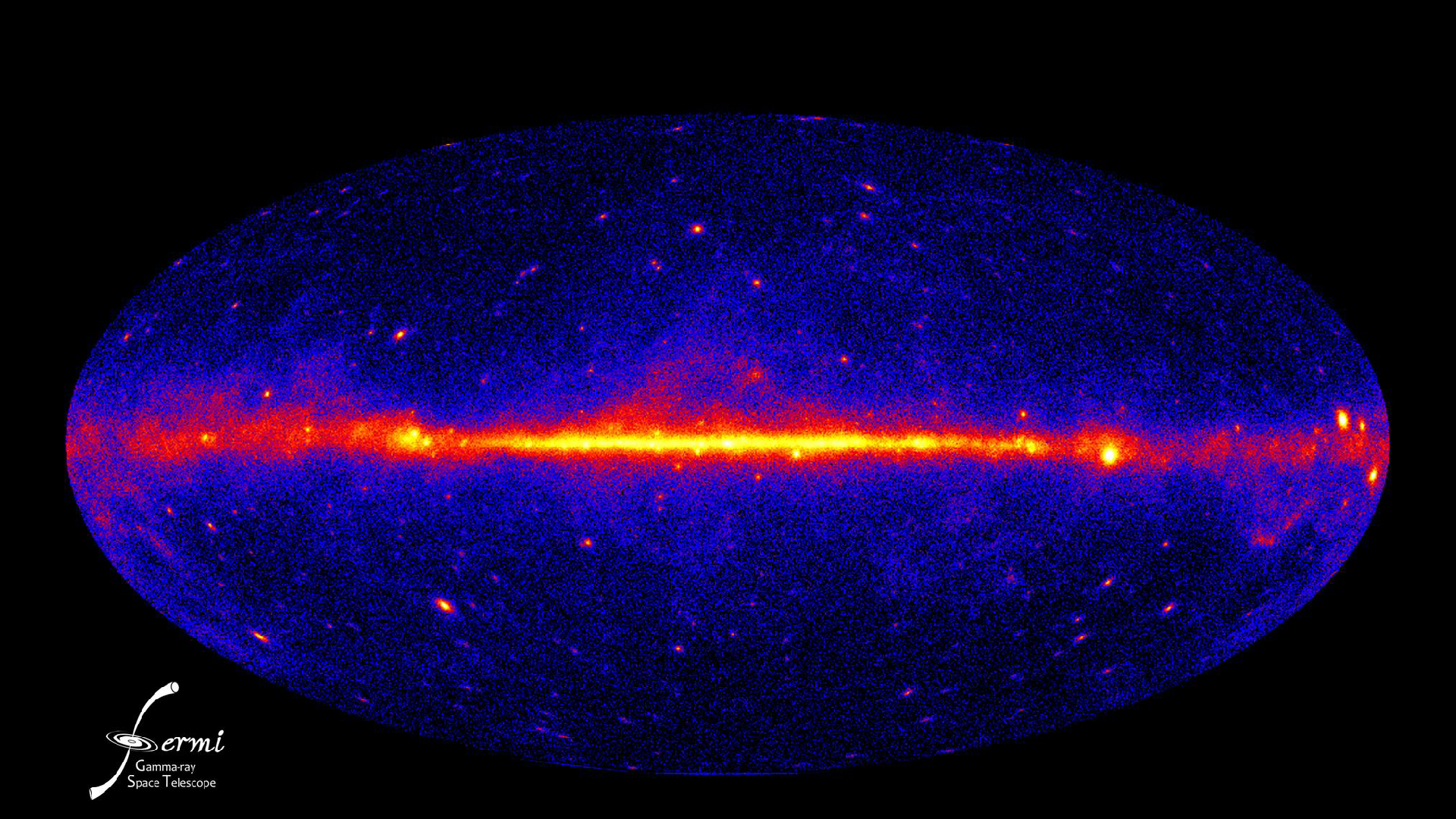Recent advanced simulations have unveiled a surprising characteristic of dark matter residing near the heart of our galaxy: it exhibits a flattened, rather than spherical, structure, challenging long-held assumptions. This unexpected discovery could offer a vital clue to the origin of a mysterious high-energy glow that has baffled astronomers for over a decade. However, researchers caution that additional studies are essential to definitively rule out alternative explanations for the enigmatic emission.
The Fermi space telescope has uncovered an intriguing cosmic anomaly: an unexpected overabundance of gamma rays emanating from the galactic core. This puzzling observation, made when the telescope was aimed directly at the galactic center, has sparked significant scientific debate.
According to Moorits Mihkel Muru, a researcher affiliated with the Leibniz Institute for Astrophysics Potsdam in Germany and the University of Tartu in Estonia, numerous theories are currently competing to explain the origin of this gamma-ray surplus, though a definitive answer remains elusive.
Initially, scientists theorized that a mysterious cosmic glow emanated from the collision and annihilation of dark matter particles. However, this theory faced a critical challenge: the observed signal’s flattened geometry diverged significantly from the spherical halos anticipated by the majority of dark matter models. This significant discrepancy steered many researchers away from the dark matter explanation, prompting a growing preference for an alternative involving millisecond pulsars—ancient, rapidly spinning neutron stars known to emit high-energy gamma-rays.
A long-held assumption about the shape of dark matter has been challenged by a new study, published October 16 in the journal *Physical Review Letters*. Led by physicist Muru, the research utilized advanced simulations of the Milky Way galaxy, revealing that dark matter near the galactic center is not perfectly spherical as previously thought, but rather flattened.
This groundbreaking finding by Muru and his colleagues offers a compelling correlation, as the observed flattened shape of dark matter precisely mirrors the distribution of gamma-ray signals detected from the galactic core.
Gamma-rays, the most energetic form of light, typically originate from the universe’s most extreme environments. These include the cataclysmic explosions of massive stars and the turbulent, superheated matter spiraling into black holes. However, even after meticulously accounting for all known cosmic generators, astronomers have consistently detected an anomalous gamma-ray glow emanating from the very core of our Milky Way galaxy—a persistent mystery that continues to perplex scientists.
Among the compelling theories attempting to explain this radiation, one posits its origin lies with dark matter – the elusive, non-luminous material making up the vast majority of the universe’s mass. According to certain astrophysical models, dark matter particles can infrequently collide and annihilate, transforming a fraction of their inherent mass into intense bursts of high-energy gamma-ray photons.
Lacking direct observation, scientists concede that much about dark matter remains unknown, as physicist Muru explained. Yet, a compelling theory suggests that dark matter particles can interact, even annihilate, upon collision. This interaction is believed to unleash energy, manifesting as high-energy radiation.
Ultimately, this theory faced a significant setback. The crucial discrepancy arose from the observed gamma rays, which exhibited a flattened, disk-like configuration, clashing directly with the prevailing astrophysical model that posits dark matter haloes as spherical structures.

A research team led by Muru initiated a critical re-evaluation of the long-held assumption that dark matter in the inner regions of galaxies must maintain a spherical shape. To conduct their inquiry, the scientists utilized the HESTIA suite, a series of advanced, high-resolution computer simulations. These sophisticated models are specifically designed to replicate galaxies akin to our own Milky Way within a realistic cosmic backdrop, enabling the team to meticulously analyze how dark matter behaves in the vicinity of a galaxy’s core.
Research indicates that the immense forces unleashed by past galactic mergers and gravitational interactions can significantly alter the typical distribution of dark matter. These powerful cosmic events are capable of molding dark matter into flattened, elongated, or even box-like structures, a configuration that remarkably mirrors the stellar bulges observed in the central regions of galaxies, including our own Milky Way.
A pivotal re-evaluation of dark matter’s structure has resolved a key challenge that previously cast doubt on certain interpretations of its nature. According to researcher Muru, the central finding reveals that dark matter near the galactic core is not spherical, as commonly assumed, but instead takes on a flattened shape. This significant insight, stemming from the correction of a simple initial assumption, marks a crucial step toward uncovering the true identity of dark matter, utilizing vital clues derived from the heart of our galaxy.
A new analysis suggests that the gamma-ray patterns expected from dark matter annihilation could naturally align with astronomical observations. This revised understanding indicates that the dark matter explanation for these cosmic signals may have been significantly underestimated, primarily because earlier scientific models relied on an incorrect predicted shape for these emissions.
Recent findings have significantly strengthened the hypothesis that dark matter is the origin of the gamma-ray signal. However, these discoveries do not definitively conclude the ongoing scientific debate. To unequivocally distinguish between dark matter and pulsars, astronomers underscore the critical need for sharper, more precise observations.
According to Muru, definitive proof for a stellar origin of the cosmic gamma-ray glow would hinge on the discovery of enough pulsars to fully account for these high-energy emissions. The prospect of resolving this astrophysical mystery is promising, as new, higher-resolution telescopes are already under construction, poised to provide the crucial insights needed to settle the question.
Future telescopic arrays like the Square Kilometre Array (SKA) and the Cherenkov Telescope Array (CTA) are poised to offer crucial insights into the mysterious radiation emanating from the galactic core. Should these advanced observatories detect a multitude of discrete, point-like sources, this finding would significantly bolster the pulsar explanation for the emissions. Conversely, if the radiation observed remains uniformly smooth and diffuse, the dark matter scenario would instead gain considerable support.
A definitive “smoking gun” for dark matter would manifest as a signal that aligns perfectly with theoretical predictions, Muru explained. Achieving this crucial confirmation, Muru emphasized, will necessitate significant advancements in both scientific modeling and the development of more powerful telescopes.
Even as the scientific community awaits the next generation of observational instruments, current dark matter models and predictions are undergoing continuous refinement. Looking ahead, researchers aim to expand the validation of these theories by exploring new environments, such as the central regions of nearby dwarf galaxies.
For over a decade, the persistent enigma of the gamma-ray excess has captivated astrophysicists, with each new investigation shedding further light on its intricate nature. While leading theories point to sources such as elusive dark matter, rapidly spinning pulsars, or even unforeseen cosmic phenomena, recent research, exemplified by Muru’s findings, highlights a crucial insight: the galaxy’s inherent structure itself may hold vital clues. By revolutionizing our understanding of the Milky Way’s dark core, scientists are steadily advancing towards answering one of modern astrophysics’ most profound questions – the true identity of dark matter.







